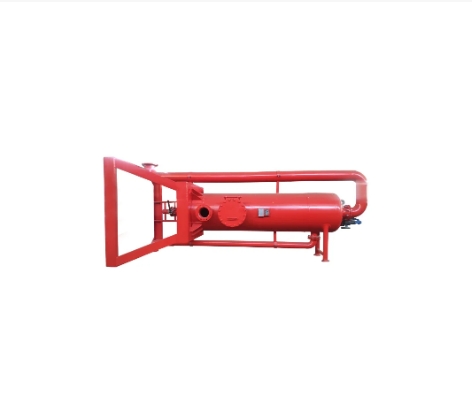In the realm of chemical processing, petrochemicals, and natural gas extraction, gas separation plays a pivotal role. This process involves separating a mixture of gases into its constituent parts, which is crucial for both operational efficiency and safety. Whether it's refining natural gas to its purest form or ensuring safe drilling operations through a mud gas separator, the underlying importance remains undeniable.

As a solids control equipment, the gas separator is designed to segregate different gases from a mixture or to remove undesired gases from a particular system. By separating gases based on their physical or chemical properties, the gas separator enhances the efficiency and safety of operations.
Purification
One of the primary functions of gas separation is purification. In industries like natural gas processing, the removal of contaminants such as carbon dioxide (CO₂), hydrogen sulfide (H₂S), and water vapor is essential. This purification ensures that the end product meets requisite quality standards, making it suitable for commercial use or further processing.
Efficiency
Gas separation technologies contribute to higher operational efficiency. For example, in oil drilling operations, a mud gas separator is used to prevent hazardous gases from entering the drilling mud system, thereby maintaining the efficiency and safety of the drilling process.
Gas separation, a critical process in various industries, finds its application in the efficient handling of gases. One such specialized equipment is the mud gas separator, which is instrumental in the oil and gas industry. These separators are designed to separate gas from the drilling mud, ensuring a cleaner and more efficient drilling process. Factories that manufacture mud gas separators are essential in providing the necessary equipment to meet the demands of this industry.
For those seeking to invest in such technology, mud gas separator for sale offers a range of options to suit different operational needs. Understanding the applications of these separators could provide insight into the broad spectrum of benefits derived from this crucial process, making them an invaluable asset in the gas separation industry.
Oil and Gas Industry
In the oil and gas sector, gas separation is imperative for both upstream and downstream operations. In drilling, a mud gas separator removes entrapped gas from drilling fluids. In refining, various separation techniques help in isolating different hydrocarbon fractions, leading to the production of gasoline, diesel, and other petroleum products.
Chemical Industry
Chemical manufacturing often relies heavily on gas separation to ensure the purity of reactants and products. Processes like cryogenic distillation, pressure swing adsorption, and membrane technology are commonly employed to achieve the desired separation, enhancing product quality and yield.
Environmental Applications
Gas separation technologies contribute to environmental conservation efforts by facilitating carbon capture and storage (CCS). This process involves capturing CO₂ from industrial emissions and storing it underground to mitigate global warming.
Medical Field
In the medical field, the production of high-purity oxygen and nitrogen for respiratory therapy, anesthesia, and other medical applications requires efficient gas separation technologies.
Several factors can influence the effectiveness of gas separation processes. Understanding these factors can help in optimizing operations and selecting the most suitable technologies.
Properties of the Gases
The physical and chemical properties of the gases involved play a significant role. Factors such as boiling points, molecular sizes, and affinities for specific adsorbents or membranes can impact the efficiency of separation.
Operating Conditions
Pressure and temperature are critical parameters. For instance, cryogenic separation relies on extremely low temperatures to liquefy and separate gases, while pressure swing adsorption operates at varying pressures to achieve separation.
Type of Separator
The choice of separator—whether it's a traditional distillation column, a membrane module, or a mud gas separator—can significantly affect the effectiveness of the separation process. Each type has its advantages and limitations, often making it suitable for specific applications.
Feed Composition
The composition of the gas mixture being fed into the separator can also impact performance. A mixture with a high concentration of target gases will generally be easier to separate compared to one with trace amounts.
Gas separation by many solid control companies, particularly in the context of a mud gas separator, faces several challenges that can impede efficiency and safety. Addressing these challenges is critical for the smooth functioning of drilling operations.
Foaming
Foaming is a common issue in mud gas separation, leading to inefficiency in gas-liquid separation. This problem can be mitigated by using anti-foaming agents or by modifying the design of the separator to include baffles or coalescing elements.
Gas Carry-Under
Another challenge is gas carry-under, where gas escapes along with the separated liquid, making the process less efficient. Upgrading to high-efficiency separator designs or incorporating additional separation stages can help address this issue.
Erosive Wear
The abrasive nature of drilling muds can lead to erosive wear of the mud gas separator. Employing materials with high resistance to wear and erosion, such as stainless steel or special alloys, can prolong the service life of the equipment.
Pressure Fluctuations
Fluctuating pressures can complicate the separation process. Advanced control systems that maintain stable pressure conditions can ensure more reliable separation.
Corrosive Environment
The presence of corrosive gases like H₂S can degrade the separator's components. Using corrosion-resistant materials and implementing periodic maintenance checks can mitigate this issue.
Gas separation is an indispensable part of various industrial processes, contributing to operational efficiency, safety, and environmental conservation. Whether in the oil and gas industry, chemical manufacturing, or medical field, the ability to effectively separate gases is crucial. While challenges exist, particularly in the context of a mud gas separator, advancements in technology and material science provide pathways to overcome these hurdles. By understanding the functions, applications, and factors affecting gas separation, along with the common challenges faced, industry professionals can optimize their operations, ensuring both efficiency and safety.